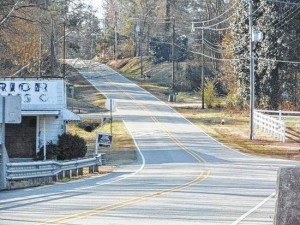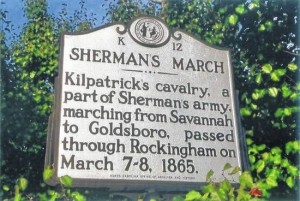
March 7, 1865, Union Army troops came running down this hill, now South Caroline Street, Rockingham, and engaged in a small skirmish with retreating Confederate Army pickets who had set fire to the bridge over Falling Creek and put out the fire.
It was 150 years ago on March 7, 1865, that Union Army troops came charging down Sandhill Road (which is now South Caroline Street) in Rockingham to extinguish fires on the Falling Creek Bridge set by retreating pickets of the Confederate Army, according to the late Joe McLaurin, Richmond County historian.
There was a short skirmish between the two forces. The bridge was saved by a water bucket brigade of Union soldiers.
That opened the way for soldiers of Brevet Maj. Gen. Hugh Judson Kilpatrick and his Third Cavalry Division of the Left Wing of Maj. Gen. William Tecumseh Sherman’s Union Army to enter Rockingham, according to Union Army After-Action Reports recently obtained by the Richmond County Historical Society.
By March 8, Union soldiers were leaving town after burning two grist mills, one at Falling Creek and another on Hitchcock Creek; John Shortridge’s woolen mill on Hitchcock Creek and Richmond Mill on Falling Creek. The Richmond County Courthouse was spared only because the home of an elderly couple might have also been burned.

This N.C. Archives and History marker is in the westbound lane of Fayetteville Road at the Richmond Road intersection.
UNION ARMY IN COUNTY
Since March 3, 1865, the 14th and 20th Corps and Third Cavalry Division of the Left Wing of Sherman’s Army had been staging near Sneedsborough in Anson County in preparation to cross the Pee Dee River some 3 miles south of that location and 10 miles above Cheraw, South Carolina.
The Right Wing of Sherman’s Army, the 15th and 17th Corps, was preparing to cross the river on a pontoon bridge at Cheraw.
The river was at flood stage which delayed the assembly of a second bridge, the 920-foot-long pontoon bridge crossing the river south of Rockingham. The 20th Corps was diverted from Sneedsborough to the Cheraw pontoon bridge to avoid further delay.
The Third Cavalry Division was 4,229 men; the 14th Corps, 13,123; and the 20th Corps, 12,498. Eventually all 29,850 men, hundreds of supply wagons, and like numbers of mules and horses, a pontoon bridge wagon train and artillery pieces were to travel through Richmond County (which at that time included Scotland County) on various routes headed for Drowning Creek/Lumber River on the east side of the county on their way to Fayetteville. There they would join the Right Wing.
In 1860, the population of Richmond County was only 11,009. At the time Union troops were crossing the county, there were more than two Union soldiers for every citizen living in the county, minus the local men away serving in the Confederate Army.
Sherman was traveling with the 15th Corps. Overall, the right and left wings of his army covered a 40-mile wide swath from Cheraw and Rockingham headed east.
Also with Sherman’s Union Army were some 500 Negro refugees, three-fourths of whom were women and children.
Kilpatrick’s Cavalry began crossing the Pee Dee River on the pontoon bridge south of Rockingham at 6 p.m. on March 6. It took all night to get soldiers and materiel across.
TROOPS ENTER ROCKINGHAM
Kilpatrick reported, “My command consisted of three brigades of Cavalry, indifferently mounted, badly armed, one Battery of horse artillery, six guns, Captain Bebee commanding, and a small Brigade of dismounted men under the command of Lieutenant Colonel Way…”
Maj. Francis L. Cramer, commander, 1st Alabama Cavalry Regiment, 3rd Brigade, Third Cavalry Division, reported: “After crossing the Great Pedee (old spelling) River and going into camp at 9 o’clock in the evening of March 6, I was ordered to take fifty men and proceed to Rockingham, N.C., about twelve miles distant, and, if possible, take the place and secure the mail.
“I advanced to within three miles of the place without meeting any opposition. I there found the road strongly picketed by the enemy, and immediately ordered my men to charge, which they did in a gallant manner, driving the enemy from post to post until we reached the edge of the village, where we found a line too strong for us to break with the small force at my command; consequently, I ordered the men to fall back slowly, which they did in good order. I then returned to camp, arriving there at 4 a.m. on the 7th.”
Lt. Col. Robert H. King, commander, 3rd Kentucky Cavalry Regiment, 1st Brigade, Third Cavalry Division, said on the morning of March 7, his unit marched on Rockingham and Capt. Boyle of his command with his company and indefinite number of infantry foragers, commonly known as “bummers,” drove Confederate Maj. Gen. Matthew Butler’s brigade out of Rockingham.
The Union force was still skirmishing with Confederates when Kilpatrick’s advance reached town.
UNION SOLDIERS CROSS COUNTY
In the meantime, with Kilpatrick in the Rockingham area, other Union troops were fanning out across the county from the 20th Corps coming up from the pontoon bridge in Cheraw as well as the 14th Corps from the pontoon bridge between Sneedsborough in North Carolina and the Pegues Plantation in South Carolina on the river.
Heavy rain had plagued Union troops from before the time of their arrival until they left the area. Mud had to be overcome with trees being cut to corduroy the roads, which meant laying logs across roadways. One Union commander said roads were, “one continual swamp.”
This delayed their movement through the county and increased the need for Union soldiers to forage further from homes and farms in the county. Confederate troops had already gathered what they could from local residents by request. Union troops did it by force, and they complained of the scarcity of goods obtained in the county.
In addition to weather conditions, from time to time Union troops engaged in small skirmishes with Confederate troops or sympathizers all around them, which slowed down their passage. Confederates were trying to slow the movement of troops to Fayetteville, which was a supply point for the Union Army.
On their way through the county, Union troops reported burning naval stores and turpentine enterprises.
UNION SOLDIERS KILLED
During skirmishes between Confederate troops of Gen. Joseph Wheeler and forgers from Union troops, five Union soldiers were killed. Their graves in recent years were identified and marked ceremoniously with federal tombstones on a farm west of Rockingham near the Pee Dee River. It was a project of the Richmond County Historical Society. They were foragers for Kilpatrick’s Cavalry.
On March 8, some elements of the 14th Corps were still encamped on Hitchcock Creek south of Rockingham. They said: “Enemy cavalry reported in strength on our left and rear.”
Before the Left Wing could continue on to Fayetteville, its engineers had to repair several bridges across Drowning Creek/Lumber River burned by Confederate forces before crossing, which delayed them another day in Richmond County.
It wasn’t until March 9 that Union Army troops were finally able to get out of Richmond County, three days after they began to enter it. In Cumberland County, Union troops were able to get on the Plank Road to Fayetteville, speeding up their travel.
One thing not mentioned in the Union Army After-Action Reports was the companion of Kilpatrick, Marie Boozer. She was the daughter of Amelia Boozer, a reputed Northern sympathizer who lived in South Carolina. They evacuated Columbia, S.C., with the Union Army.
She reportedly stayed with Kilpatrick when in Rockingham in the house at 613 Fayetteville Road. Marie was with him on March 10 in a log cabin at Monroe Crossroads in Cumberland County when Confederate cavalry routed him from the cabin in his nightclothes.
He escaped through the woods before recovering his command and counterattacked. Miss Boozer later lived an infamous and checkered life.
The Union After-Action Reports also did not mention the burning of any mills in Richmond County. Reports were mainly related to troop movements.
